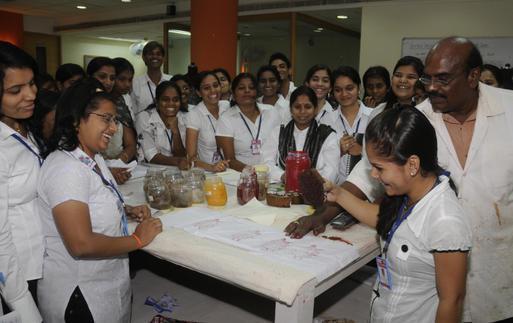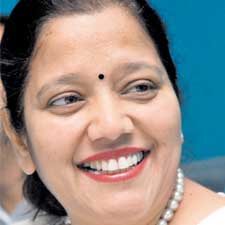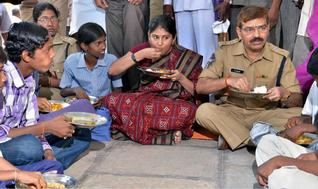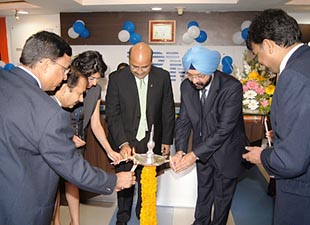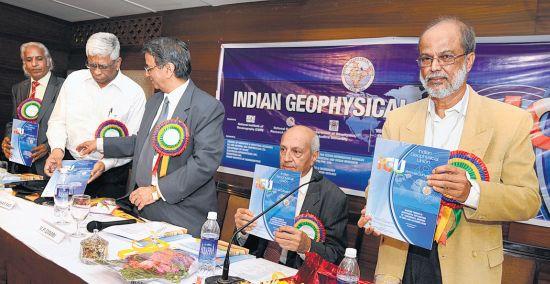Hyderabad to Vijayawada, it’s a trip from tangy to the fiery-hot
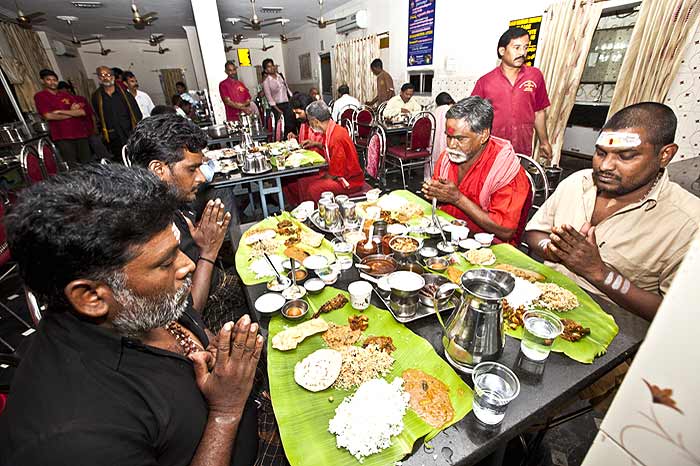
Andhra full meal . At the Viyawada Ramiah mess/ A. PRABHAKAR RAO
I am, I must confess, an accidental food writer. It all started with a one-off food story, which led to another, and another…till now I’m being asked to write culinary books and host TV shows. But, truth be told, my idea of the perfect meal is a simple, crisp dosa, accompanied by a favourite book. Hence this culinary drive from Hyderabad to Vijayawada turned out for me to be more of a journey through history and geography, with random diversions through politics and trivia.
Hyderabad is one of the important centres of Mughlai cuisine, along with Delhi, Lahore, Lucknow and, perhaps, Rampur. But there’s an important difference: by the time the 50-year-long Deccan campaign ended, the cuisine that the Mughal armies had brought with them had evolved, through its interaction with the southern climate, ingredients, peoples and cuisines. Most notably, it acquired a distinctive tangy undercurrent, thanks to a variety of sour flavourings, from tamarind to green mango. Thus, biriyanis, qormas and kababs are all very well, but the keynote of Hyderabadi cuisine is a khatta salan (sour curry)—such as baghare baigan, tamate ka kut or a simple khatti dal—which is the starting point for planning any Hyderabadi meal. Everything else, whether lamb, fowl or fish, comes later. This is something north Indian Muslims find rather strange—almost as strange, in fact, as the Hyderabadi Urdu dialect.
|
|
|
|
Khatta salan comes first in Hyderabadi cuisine, before fish or fowl, something north Indian Muslims find strange. |
|
|
|
|
Because it originated as a cuisine of the elites, Hyderabadi cuisine is generally a slow-cooked labour of love. Even the humblest dish calls for a certain artistry, and presentation is as important as flavour, texture and fragrance. So where can you get good, authentic Hyderabadi food? Unfortunately, the answer is that it’s something you get only in people’s homes. Well, there are two other possibilities: Hyderabadi weddings and the Nizam Club, so you could try to wrangle an invitation, or gatecrash. Alternatively, there’s Shadaab, a little eating house in the Old City, or the slightly more upmarket Point Pleasant in Banjara Hills. But your best bet would be to order from somebody like Begum Aziza Hassan, famed for her pluperfect shikampurs, baghare baigan and biriyani. |
The drive from Hyderabad to Vijayawada—the heartland of Andhra cuisine—takes only five hours, but it’s a journey into a different cultural ethos. The road heads east, through dramatic rockscapes, some of the last remnants of the famous boulders of Hyderabad, sculpted into fantastical formations by 2.5 billion years of wind and storm; the rest, sadly, have fallen prey to real estate development, and a unique national treasure has been squandered.
The road takes us through places whose names all seem to end in either ‘pally’ or ‘gudem’ (Tangallapally, Maggalapally, Yellareddigudem, Annapareddigudem). Our driver insists on driving on the wrong side of the road, at 140 kmph. Every time I admonish him, he obediently gets back into his lane—but only briefly. I think I’m going to have a cardiac arrest, as he continually swerves left at the last possible moment to dodge oncoming vehicles. Hesitantly, I ask him how long he’s been driving this route. “Seven years, sahib,” he replies, impassively. I philosophically tell myself he knows what he’s doing, and close my eyes and try to sleep. But I swear to myself there’s no way I’m going to go back this way; I shall return to Hyderabad by train.
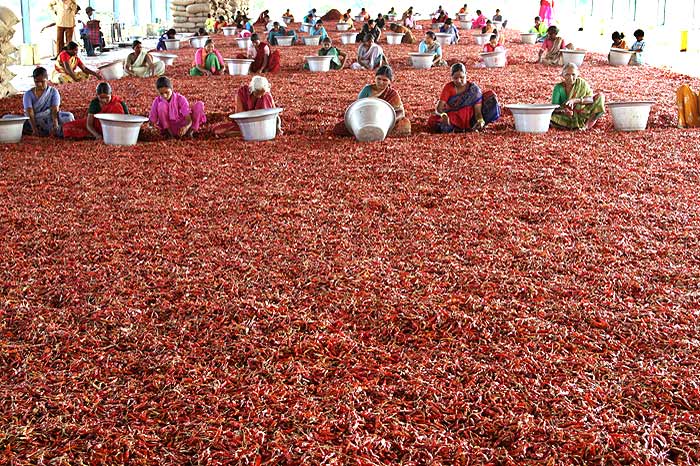
Chilli land Guntur’s firestick chilli is delectable torture. (Photograph by T. Narayan)
As we approach Nalgonda, the land flattens out, with lines of pencil-straight toddy palms. In the summer, villagers sit by the roadside, selling tadgolas, the fruit of the toddy palm—translucent, cool, luscious under their fleshy ochre skin. Apart from these, and the creamy local sitaphals, foodwise, the drive is uninteresting; it’s only near Guntur that things look up, with the nondescript dhabas giving way to stalls selling scorching chilli mirpakaya bajjis.
From Nalgonda, the road swoops south, and the landscape slowly turns a lush shade of green: this is the rice bowl of India, watered by the Krishna river. We’re now crossing the divide into coastal Andhra—the historic ‘Coromandel Coast’ where, in the 1750s, the French and British intrigued and battled so fiercely. At first, the French seemed well-entrenched here, but the English, of course, ultimately finessed them. They absorbed this strategic coastal belt into their Madras province. And so it remained, right until 1953, when it became India’s first linguistic state, Andhra. Then, three years later, the Telangana region was added on to it—a political marriage that’s been on the rocks for 40 years. All that’s left of it now is a bitter tussle over who gets to keep the dowry of Hyderabad. (So much for the logic of linguistic states.)
Apart from being India’s rice bowl, coastal Andhra also claims to produce the sweetest jaggery, the thickest curds and the best chillis. Guntur, in fact, is perhaps the chilli capital of the world: it is home to the world’s largest chilli market, and its chilli farms make the largest single contribution to India’s output of 1.1 million tonnes of chillis per year. And while its chillis may not be the world’s hottest (that distinction goes to Assam’s bhootjholokia chilli), the Guntur ‘firestick’ chilli is hot enough for the police to use, allegedly, as a means of torturing stubborn suspects. This is hard-core chilli country, and you see evidence of it everywhere, from the vivid scarlet stretches of drying chillis by the roadside to the city’s eating joints, which offer foods that run all the way up the Scoville scale, from the merely spicy to the truly incendiary. (The gunpowder-sprinkled ‘Guntur idlis’ are a speciality.)
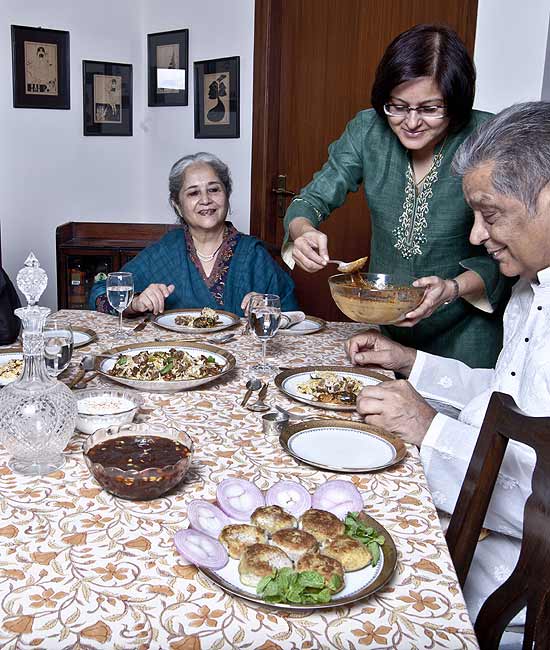
Family affair A Hyderabadi meal. (Photograph by A. Prabhakar Rao)
If Hyderabadi cuisine was largely the product of history, Andhra cuisine is a result of geography. Its themes are rice from the delta; tamarind, green mango and gongura (sour roselle leaf) that grow here in abundance; dour vegetables like brinjal, lady’s finger, drumstick and gourd; fresh seafood from the coast and, of course, the chillis of Guntur. The cuisine, unsurprisingly, is one of the world’s hottest, and so a meal always ends with a soothing dollop of curd-rice—the ancient secret for dousing the fire of the chillis (the ancients intuitively understood that chilli molecules are fat-soluble, not water-soluble, which is why cold water never helps).
A typical Andhra meal includes steaming rice, a pappu or dal, a couple of pulusus or curries and rasam. There might also be a sambar and chaaru (something roughly in between a sambar and rasam). And for extra zing, there’ll be an array of pickles, chutneys and kaaram, or spicy powders. The items are laid out on your banana leaf in an ergonomic, traditional pattern: rice in the middle; curries on the right; pickles and pachadi on the left; and special delicacies, like pulihora, in pride of place at the top right-hand corner. The thematic flavours are chilli and gongura, and given the fact that Andhra is such an intensely political state, such characteristics sometimes acquire a political undertone: during the Separate Telangana movement, for example, there was crude graffiti shouting not just ‘Andhra go back!’ but also ‘Gongura go back!’ and ‘Mirchi go back!
|
|
|
|
What if the French had trumped the English in Andhra? Would we be eating creolised fish pulusus? |
|
|
|
|
Unlike Hyderabadi cuisine, Andhra cuisine never had the advantage of court patronage—which played an important role in the evolution of, for example, Telangana cuisine. It was, instead, essentially the food of the common man—which is why it remained simple, earthy and robust. It’s interesting to speculate what would have happened to Andhra cuisine if history had turned out differently. What if the intrinsically Telugu Vijayanagara empire had conquered the Cholamandal coast, and lasted a century longer? Or, what if the French—who were once well-ensconced here—had trumped the English, and wrought a Pondicherry-like influence on the region and its cuisine? Might we, perhaps, today be eating creolised fish pulusus with baguettes made of rice-flour? |
From Guntur, the road turns north and crosses the Krishna river into Vijayawada. One of the city’s landmarks is Babai Hotel, originally a footpath stall set up in 1942 by Patruni Shyama Murthi, affectionately called ‘Babai’ (uncle), who invented what many consider to be the ultimate idli: a supremely fluffy creation, topped with a blob of home-made butter. Babai’s idli became so popular that his stall became a pilgrimage centre for Andhra Pradesh’s film stars, tycoons and politicians, and it’s said that the idli had no fixed price: wealthy patrons would simply hand over a sheaf of notes, based on how much they’d enjoyed their meal. Today Babai’s idli joint, now run by his nephews, may not be what it once was, but it’s still a shrine for foodies.
Our journey had ended; it was time to go back. I took one look at our driver and recalled our trip from Hyderabad, driving on the wrong side of the road, at 140 kmph. It didn’t take long to make my decision. I paid him off and caught the Narsapet-Hyderabad Express instead. Discretion, truly, is the better part of cowardice.
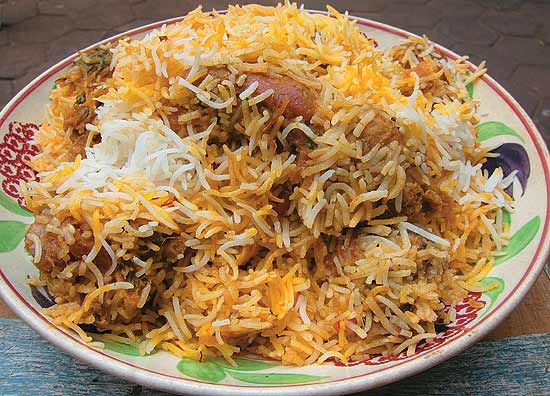
Do-Gosht Biriyani
One of the secrets of a good Hyderabadi biriyani is said to be the generosity of the proportion: it should ideally be one portion of meat for every portion of rice. And then there’s the ‘do-gosht biriyani’, or two portions of meat for every portion of rice! Two much of a good thing.
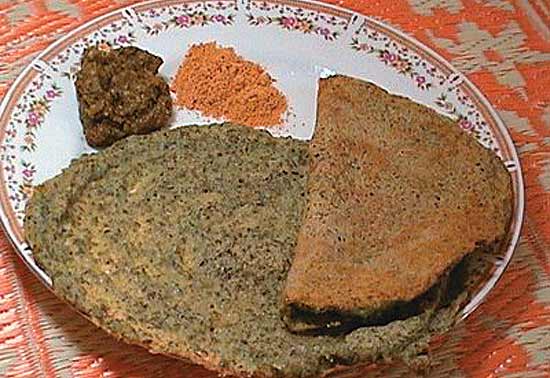
MLA Pesarattu
Pesarattu is the Andhra version of a dosa, but made of green gram instead of rice. A popular variant is the ‘MLA pesarattu’, stuffed with upma. It apparently got its name from the state’s MLAs, who invented this greedy snack in the MLA canteen to sneak into the assembly and eat during long, boring sessions.
___________________________________________________________
When he’s not waxing eloquent on food, Anvar Alikhan is an advertising professional
___________________________________________________________
source: http://www.OutlookIndia.com / Society / Magazine, January 07th, 2012
Special Issue: THE AROMAS OF INDIA
